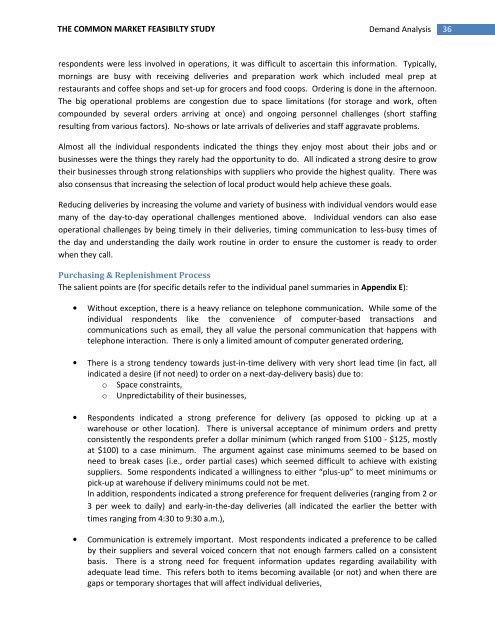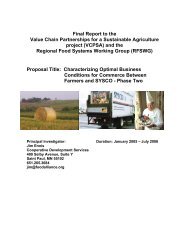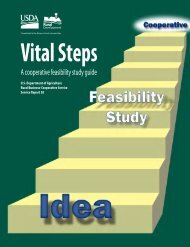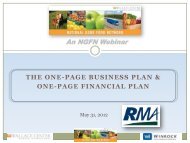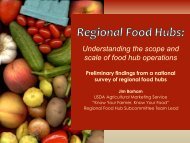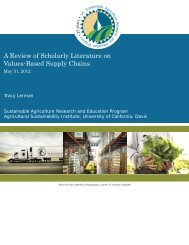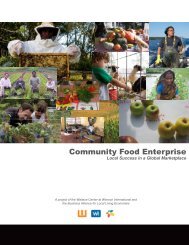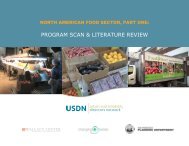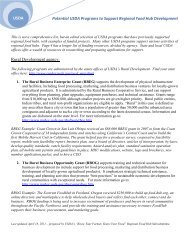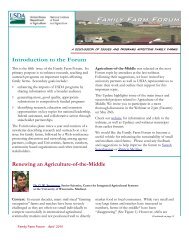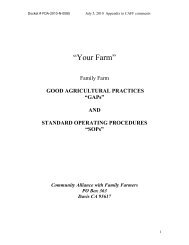The Common Market Feasibility Study - Agricultural Marketing Service
The Common Market Feasibility Study - Agricultural Marketing Service
The Common Market Feasibility Study - Agricultural Marketing Service
Create successful ePaper yourself
Turn your PDF publications into a flip-book with our unique Google optimized e-Paper software.
THE COMMON MARKET FEASIBILTY STUDYDemand Analysis36respondents were less involved in operations, it was difficult to ascertain this information. Typically,mornings are busy with receiving deliveries and preparation work which included meal prep atrestaurants and coffee shops and set-up for grocers and food coops. Ordering is done in the afternoon.<strong>The</strong> big operational problems are congestion due to space limitations (for storage and work, oftencompounded by several orders arriving at once) and ongoing personnel challenges (short staffingresulting from various factors). No-shows or late arrivals of deliveries and staff aggravate problems.Almost all the individual respondents indicated the things they enjoy most about their jobs and orbusinesses were the things they rarely had the opportunity to do. All indicated a strong desire to growtheir businesses through strong relationships with suppliers who provide the highest quality. <strong>The</strong>re wasalso consensus that increasing the selection of local product would help achieve these goals.Reducing deliveries by increasing the volume and variety of business with individual vendors would easemany of the day-to-day operational challenges mentioned above. Individual vendors can also easeoperational challenges by being timely in their deliveries, timing communication to less-busy times ofthe day and understanding the daily work routine in order to ensure the customer is ready to orderwhen they call.Purchasing & Replenishment Process<strong>The</strong> salient points are (for specific details refer to the individual panel summaries in Appendix E):• Without exception, there is a heavy reliance on telephone communication. While some of theindividual respondents like the convenience of computer-based transactions andcommunications such as email, they all value the personal communication that happens withtelephone interaction. <strong>The</strong>re is only a limited amount of computer generated ordering,• <strong>The</strong>re is a strong tendency towards just-in-time delivery with very short lead time (in fact, allindicated a desire (if not need) to order on a next-day-delivery basis) due to:o Space constraints,o Unpredictability of their businesses,• Respondents indicated a strong preference for delivery (as opposed to picking up at awarehouse or other location). <strong>The</strong>re is universal acceptance of minimum orders and prettyconsistently the respondents prefer a dollar minimum (which ranged from $100 - $125, mostlyat $100) to a case minimum. <strong>The</strong> argument against case minimums seemed to be based onneed to break cases (i.e., order partial cases) which seemed difficult to achieve with existingsuppliers. Some respondents indicated a willingness to either “plus-up” to meet minimums orpick-up at warehouse if delivery minimums could not be met.In addition, respondents indicated a strong preference for frequent deliveries (ranging from 2 or3 per week to daily) and early-in-the-day deliveries (all indicated the earlier the better withtimes ranging from 4:30 to 9:30 a.m.),• Communication is extremely important. Most respondents indicated a preference to be calledby their suppliers and several voiced concern that not enough farmers called on a consistentbasis. <strong>The</strong>re is a strong need for frequent information updates regarding availability withadequate lead time. This refers both to items becoming available (or not) and when there aregaps or temporary shortages that will affect individual deliveries,


